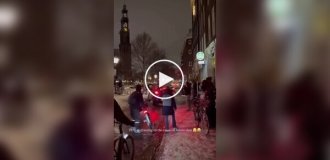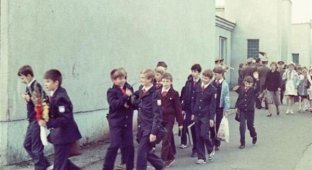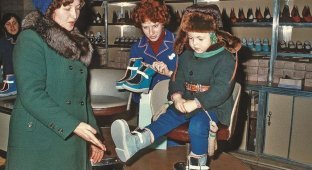About school uniforms and school in the 60s and 80s.

I'm trying to remember something good about the Soviet school of the 60s, but I can't.
Pioneer ties, plush banners and stuffed children.
The worst thing was that individuality was suppressed; if you stood out, you got hit on the head.
I still remember wooden pens with feathers, blots, sippy cups, the first ballpoint pens, multi-colored ones - an object of prestige and envy.
But first, about the school uniform:
School uniforms came to Russia from England in 1834, at the same time a general system of all civilian uniforms in the Russian Empire was approved, including for secondary educational institutions.
First for boys, and after the opening of girls' gymnasiums - for girls.
In 1836, a set of rules regarding color and style even appeared.


A blue cloth tunic with silver raised buttons, a black lacquered belt with a silver buckle and black trousers were the everyday clothes of a middle school student.

High school students dressed in a jacket with a stand-up collar, reminiscent of a naval jacket.
On weekends, high school students wore a dark blue or dark gray single-breasted uniform with a silver braid around the collar.
--------------Girls-----------


Girls' dresses were made from camelot (thick wool or wool blend fabric).
Pupils of state gymnasiums wore brown dresses with a high collar and aprons - black on school days and white on holidays. Before the revolution, the female uniform was complemented by a hat, usually a straw one.

-------------THE USSR------------
Soon after the revolution, “as part of the fight against bourgeois remnants and the legacy of the tsarist police regime,” a decree was issued in 1918 abolishing the wearing of school uniforms.
The official explanations were as follows: the uniform demonstrates the student’s lack of freedom and humiliates him.

The school uniform appeared again in 1948, and in all respects it resembled the pre-revolutionary one.

Girls wore a brown dress with a black (everyday) or white (for special occasions) apron, tied at the back with a bow.
The dresses had white collars and cuffs and could be trimmed with lace.
Wearing a collar and cuffs was mandatory.
In addition to this, girls could wear black or brown (everyday) or white (ceremonial) bows. Bows of other colors were not allowed according to the rules.
Even the hairstyle had to meet the requirements of Puritan morality - “model haircuts” were strictly prohibited until the end of the 50s, not to mention hair coloring. Girls always wore braids with bows.
In addition, after the war, separate education was introduced, which, however, was abandoned a few years later.
The most minor experiments with the length or other parameters of the school uniform were severely punished.
The school uniform of that era can be seen in the films “First-Grader”, “Alyosha Ptitsyn Develops Character” and “Vasyok Trubachev and His Comrades”.
------------1960s----------

Boys wore gray wool-blend tunics; in the late 60s they were replaced by a single-breasted gray jacket-type top.

Photographer Mikhail Ozersky, 1963
-------------Girls---------
The girls' dresses were almost the same, but the aprons were different - the simplest from cheap fabric, and very beautiful (even black, everyday ones).
They were either sewn or obtained through connections: with frills, tucks, pleated or corrugated wings.

In the early 60s, ribbons were made of satin and had to be rolled and ironed all the time.
A little later, nylon tapes appeared, and it was easier with them.
It was difficult to find children's shoes in the early 60s; at Detsky Mir there were huge lines snaking through the floors and down the stairs.

This is a shot from the film “We'll Live Until Monday”, a teacher with a “lousy house” on her head is a typical example of an official lady of those years.
At that time, “babette” and bouffant were in fashion, but girls were forbidden to wear such hairstyles to school - only braids or ponytails.
This is one of the fashionable haircuts of those years:

If you had hair like that or a little longer, not even shoulder-length, you could be kicked out of class to make ponytails with pharmaceutical black elastic bands; there were no others then.
In high school we didn’t wear uniforms, but my friend and I were always sent out to put our hair in ponytails.
She walked resignedly, since her academic performance was not very good, and I endured and endured, but somehow I couldn’t stand it and told the class that I wouldn’t lose anything from her level of teaching English, I don’t have to come at all.
Oh, what started here: Komsomol meetings, speeches by Komsomol activists on the topic of modesty in clothing and behavior, dear mother!
They couldn’t do anything with me: after new rules for medals were introduced (there shouldn’t have been fours in a quarter), I remained the only candidate. And I never had a B in my life (except maybe once in the history of the CPSU, already at the institute), because my memory was such that there was no need to study it.
But it was disgusting to study among sycophants and hypocrites, so with great difficulty I transferred to another school through the GORONO.
Looking ahead, I will say that my mother “revenged” me.
A few years later, when I was already working as a costume designer after college, she came to Sochi on vacation and met my “cool classmate.”
At that time, the profession of a fashion designer was rare, and working in cinema was even more so.
The former “cool girl” watched both “12 Chairs” and “Duenna” - my first films.
But she still believed that running her fingers through her students’ hair and checking to see if there was a comb was normal.

Last call, 1968.
Here the girls already have fashionable hairstyles, almost all of them have a bouffant, on the left is a “babette”, no “rat tails” or braids with bows, they were so annoying at school.
I must say that in the Baltics in those years the school uniform was very beautiful: sundresses complete with blouses (a festive version even with a pleated frill), a friend from Estonia sent us.
---------Pioneers, Octobrists and Komsomol members-----------
I no longer found the best friend of Soviet children, grandfather Stalin, but grandfather Lenin was treated to all kinds from early childhood.
This especially gained momentum by 1967 - it was 50 years since the “Great October Socialist Revolution,” which for contemporaries was just an “October revolution.” Portraits of Lenin were everywhere on the streets, the memoirs of his comrades-in-arms were published in millions of copies.
And in schools they wrote essays “about a kind grandfather.”
But at school there were still flowers, but at the institute taking notes of his works and memorizing party congresses was a real punishment!
But back to school:
Pioneers had a red tie (there were simple satin and acetate silk ones), Komsomol members and Octoberists had a mandatory badge on their chest.

Oktyabryatskaya "star" with Ilyich in childhood.






Pioneer camp, 1960.

1975 Moscow. The pioneers go to the mausoleum.

Such marches were held after numerous rehearsals, with patriotic chants.
The so-called “montage” was also very popular, when children went on stage together and took turns reading patriotic poems.
Ideology was forcibly hammered into the children's heads; the truth about Lenin began to emerge not even at the beginning of perestroika, but later, when it was allowed to print his statements and cruel orders without cuts.
In the 70s, the enthusiasm of the first Komsomol construction projects gave way to practicality; many who had committed fines went to the same BAM in order to reinstate themselves at the institute or make a Komsomol career.
----------About the school of the 60s and 80s---------
I personally was annoyed by the equalization in the program; it was boring to study because they were equal in terms of the average level.
There was no external course, and only those gifted in physics and mathematics had the opportunity to enroll in special education. establishments.
To be fair, it must be said that in the 60s there was not yet a widespread practice of bribes and gifts to teachers for grades, then this blossomed in full bloom, as did “working extra” for money.
And in the institutes they didn’t pay for tests and exams, if there were isolated cases.
But teachers and lecturers worked for pennies, this led to the degradation of the staff.
People who had not been accepted into other, more prestigious institutions began to enroll in teacher training universities.
I had the opportunity to work for a year at a school in Kabul, at the very beginning of the war in the 80s, there I saw the teacher’s room from the other side and was simply amazed and killed.
Some of the teachers were sent from the Union, and most of them were recruited from the teachers-wives of business travelers.
The level of some was simply murderous; they could not even speak competently.
Teachers could easily stop a bus with children if they saw a seller of used shoes with a bag (help from many countries was coming to Kabul from many countries), jumped out and started trying them on (on bare feet, without complexes) and bargain furiously.
What to take from them if the head teacher, the general’s wife, openly boasted in the staff room about how she buys things on the cheap.
My husband took an Afghan sub-Soviet to the market, who was in charge of army recruitment; as soon as he made a subtle hint, the dukan sellers quickly lowered the price.
But in terms of ideology, the same window dressing reigned.
On February 23, the day of the Soviet Army, children from all over Kabul were taken to the embassy for a solemn event, although they knew that provocations were possible on this day.
And the parents knew, but they sent their children away.
The drive to the embassy was not close, about half an hour. The convoy of school buses was not accompanied by military equipment; if something had happened on the road, the machine gunner on the bus would have been of little help.
I remember the children came out of a screening of a film about the war, and in the direction of the microdistrict where the main part of the “Shuravi” lived, explosions thundered.
No one knows whether to go or not to go home with the children. The “socialist countries” rush their children to their cars and villas, while ours stand at the gate, almost crying.
While we were waiting for the armored personnel carriers, until we got there, there was a nightmare: someone’s entrance was blown up, someone was hysterical.
But, most importantly, they checked the box that the children were taken to the event.
I also remember how Brezhnev died and his portraits were thrown out at the embassy; children kicked them without any respect. Everyone laughed at Ilyich-numbert in recent years, but still no one expected a surprise in the form of Chernenko.
What also struck me was the school sewing curriculum, it has not changed in twenty years, all the same aprons and terrible nightgowns.
But more about this and how we had to get out of the situation in the next post.
PS
Now, I'm afraid the situation is no better.
I read about the Unified Economic Examination, about the reduction of subjects, about the introduction of new ones, such as the Law of God, under the guise of the history of religions.
The Soviet school had many shortcomings, but it also had many advantages. She suppressed personality, but provided education.
Apparently, semi-literate people who are infatuated with “House-2” and other moronic programs are easier to manipulate.
Another PS.
In principle, I am not against school uniforms; they allowed children from wealthy and poor families to be less clearly distinguished.
But wearing a brown dress for ten years is too much.
Comments have already begun in the spirit: it was strict, but they grew up as people.
Then where did the bandits and thieves come from during perestroika? Did they graduate from Soviet school?
And why did all the party and ardent Komsomol members become believers without even really reading the Bible, only observing external rituals?
After all, few people baptized children and went to church; mostly, editorials were read at meetings and the appearance of “black sheep” was discussed.























